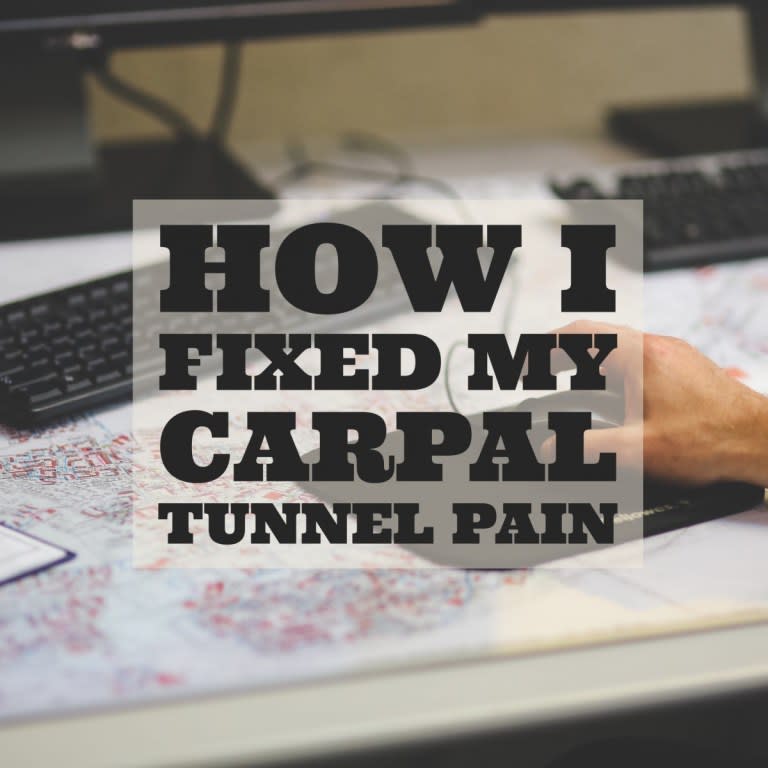This post was first published on CoderHood as How I Fixed My Carpal Tunnel Pain. CoderHood is a blog dedicated to the human dimension of software engineering.
Coding is Deceptively Safe.
Software Engineers spend the majority of their work hours sitting in front of a computer, typing on a keyboard or moving a mouse. At work, we don't lift heavy things or climb on ladders, and there aren't many job injuries caused by writing code. The most common ones I have seen are lower-back problems and wrist problems.
Lower back pain.
I am not a doctor, I know nothing about medicine, and I am not qualified to give any medical advice. However, I have been around developers all my life and I have seen many of them suffer from back pains due to sitting all day.
That kind of issue is sometimes easy to resolve by standing up often or using a standing desk. That's how I did it. I have a desk that can go up and down, and I spend part of the day standing up and part of the day sitting. Doing this worked for me, and I have been lower-back pain-free for many years.
Then there is Carpal Tunnel Syndrome.
There is another issue that can make your developer life very difficult, and even get in the way of your career. It is the infamous Carpal Tunnel Syndrome or CTS. There are many causes for this condition, some behavioral and other metabolic. For developers, the most common one is repetitive maneuvers due to working with a keyboard and mouse all day.
I am right handed, and I had carpal tunnel issues on my right wrist for at least 20 years; maybe longer. It was a pain. Literally. My thumb, index finger and middle finger would go numb whenever I did anything repetitive with my right hand. For example, working with tools in my workshop, painting, writing, and drawing. In other words, many things that I like to do in my free time.
For the longest time, I didn't know what it was called and didn't pay attention to it. Then, it got worse and hard to ignore.
It Got Worse Over Time.
In the last few years, things started getting worse. My hand would go numb anytime I would raise it above my head for more than 10-20 seconds. Sometimes it would go numb at night, and other times for no reason whatsoever.
I grew tired of it and tried many different things to fix it. Pain relief topical medications, splints, compression gloves, pain killers, massages, ice, heat, you name it. I spent hundreds of dollars trying everything I could try.
Finally, I found two products that resolved the problem for me.
The "M BRACE RCA"
When I bought this poorly named product, I was at the end of my list of stuff to try. This thing seemed way too simple, and the $25 price tag too steep, for a piece of plastic attached to a strip of velcro. Regardless, I was on a mission to resolving my wrist issues without surgery. I had to try it, and I ordered it from Amazon.
When I received it, I laughed. It is a very simple plastic bracelet, and it was hard to believe it would do anything. I am not sure what I was expecting given that it is exactly as described on the Amazon product page. I decided to get past my disbelief, and I wore it 24/7 for a couple of weeks. I never took it off, even if the instructions recommend keeping it on during the day and taking it off at night.
Well, it was like magic. My pain went away, just like that.
Since then I haven't had any symptoms of CTA. I can raise my hand over my head for extended periods, type, write, use the mouse, work in the workshop, paint, draw, and do anything without feeling any numbness or discomfort. It has been a lifesaver, and it increased my quality of life. I wore it 24/7 for several months, and I never felt like it restricted my movements.
I took it off a few months ago when it started causing a mild skin irritation. That should teach me to follow instructions, but it probably won't. Regardless, the pain has not returned. I am sure it will in the future, but at this point, I know what to do if it does. I'll put the bracelet back on, and maybe I'll even take it off at night. Maybe.
How does it work?!?
Since I am a geek, I had to know how this simple contraption works. I found the answer reading the bracelet's patent (US5385537). The ugly technical drawing included in the patent documents shows the concept:
For details, I encourage you to read the patent. Since I know you won't (hey, we are engineers!), let me give you a quick summary. The idea is simple: Referring to Fig. 2, when you have CTS your Median nerve (23) is squeezed between the Radius (15), the Ulna (16), and the Transverse Carpal Ligament. The ligament is not indicated in the figure, but it is a band somewhere between the Median nerve (23) and the wrist (14).
The following image shows the hand numbness in red and the Transverse Carpal Ligament on the rightmost hand drawing.
When the bracelet is around the wrist, it applies pressure in strategic spots and brings the Radius and the Ulna closer to each other. That pushes the Transverse Carpal Ligament further away from the Median nerve and the bones, relieving the pressure in the Carpal Tunnel.
Straightforward and efficient. And yes, probably a bit overpriced, but... oh well. It works, and I would have paid any amount of money to get that problem resolved without surgery.
J-Tech Vertical Mouse
The M BRACE RCA was great to remove the pain from my wrist, but I still wanted to find a way to eliminate the behavioral cause of my CTS. Since I had issues only with my right hand, I speculated that the constant use of a mouse --- I am right handed --- was to blame. To resolve the problem, I purchased a vertical mouse to change my wrist position to something more natural, or at least different.
There are many vertical mice on the market. I went with the J-Tech Vertical Mouse which is an inexpensive option with good reviews on Amazon. It took me a few days to get used to it, but it grew on me, and now I like it a lot.
Conclusions.
I believe that the M BRACE RCA is what removed the pain from my wrist, and allowed my carpal tunnel inflammation to subside. I also believe that using the vertical mouse has helped to keep the inflammation away, even after taking the bracelet off.
If you suffer from CTS, I strongly recommend giving it a try. It helped me, and I am hopeful that can help you too.
If you enjoyed this article, keep in touch!
- Find all my posts on CoderHood.
- Join my professional network on LinkedIn.
- Follow me on Twitter.
- Join my Facebook page.
- And finally, follow me here on dev.to!











Oldest comments (32)
Wow, I'm going to try this out. @andy this is probably helpful for you too.
Did you ever consider trying the Dvorak keyboard? I know a few people that's helped, but haven't gotten around to it myself because it feels like such a big transition.
I have not tried super-ergonomic keyboards for a few reasons.
The first one is that only my right wrist was hurting, and I use right and left equally when I type. That made me think that it wasn't a keyboard problem, but a mouse problem.
The second one is that I use several different computers. I have a laptop at work that I carry around everywhere, an iMac at home, another laptop at home that I use when I don't want to be in the office.... so I'd have to buy multiple keyboards and carry them around with me.
If I was only working on one machine, I would have tried for sure. ANYTHING to stop that tingling pain. I am just glad I found a solution that works, for me at least. Hope it works for others too.
I feel more pain in my right hand than my left, and that leads me to think it's a mouse problem too. I do feel pain in both wrists though.
That said, I've been on the same ergonomic keyboard Jess uses and it's been a great two days. I'm also making a switch to not use the mouse, and I think that will be a good long term benefit.
Definitely going to try it out too!
I was always curious about standing desks. Have you tried only standing up? I imagine spending most of the day standing up have inconveniences also?
Yes, you are right. Standing all day is also a problem. That is why I go up and down depending on how I feel. I found that I spend about 50% of my time standing, the rest sitting.
May I ask in what desk you invested in ?
The company I work for purchased raising desks for everyone. I think the one I have was custom made for the office.
We had a simple table with longer legs, and it was amazing. Standing over long periods of time can be detrimental as well, but alternating between one or two hours in either position yields great results!
I'm using computers heavily for 20 years now and never got this problem.
I don't know if I simply got superior wrists or some of the things I did while working with computers helped.
I used vertical mouses, avoided mechanical keyboards and had mouse pads with padding for the wrist all my adult life.
Probably all the things you did (vertical mice, comfortable keyboards, and pads with padding) saved you. Also, I am pretty sure it has something to do with genetics. If your carpal tunnel channel is wide enough, you'll probably be fine forever.
s/Overtime/Over Time/
I use a trackball, so while I might have some occasional discomfort, I don't have nearly that level of problem. A Twitter friend suggested a vertical mouse, and first time I tried to put my M570 at an angle, I said "Oh!" There's a new adjustable trackball from Logitech that allows setting that angle; work will buy me one soon.
Smart move to attack the problem from both ends. Good luck and thanks for the links.
Ah, thank you for the s/// !! I missed that one in my editing. Fixed.
I have had these issues for 3 years including back pain and neck pain uneven hips...
The solution, is what you suggested, but to add more to it, exercise and stretch! It was all gone after 1 month.
Exercise is definitely good. It never fixed my wrist, but it was great for the back.
I'm glad to see Practical Dev exploring this!
My issue is inflamed muscle running down my left forearm – nothing in the right, not much in the fingers, but maybe some sensitivity in the top of my left hand. I'm going to try out Lorenzo's recommendation, but if anyone else has this same ailment, I'd love to share information!
I embraced CTS many decades ago...suffered for a few years until I worked out how to manage if. For me that's: ergo keyboards, trackpad and mouse on either side of the KB, various other office setups.
But key -and this was by accident- was taking up rock climbing. This built up my forearm muscles and made things go away. Now I need to do it intermittently, or at least use an extra hard grip/wrist thing you squeeze to build up strength. I have to do this, have accepted its a price of my job. But climbing is fun anyway. My recommendation for others: go to a sports physio
I've actually noticed that using a grip strengthener thing has helped my wrist pain a bit. Glad to hear someone else thinks the same.
i don't have the CTS too bad just yet but i do try and use the grip strengtheners. in addition to that i have these pretty rando things that are meant for guitar too. back when i used to be cool i used these to 'shred' on my 'axe' haha. they helped with finger strength a lot too.
maybe the combo of forearm/finger strengtheners has actually worked to my benefit. now if i could just get my back to stop hurting... haha
Interesting. I recently climbed super hard and it took my wrists much much longer to recover which I suspected was do to CTS. Now when I climb, I feel like my wrists/forearms get tired out very quickly and have been really nervous about pushing myself.
I've been climbing (boulder) for 3 years now and CTS has been getting worse for a little over a year. I have tried using a regular mouse, a vertical mouse and a trackpad (on a 2015 MacBook Pro), results don't change that much.
An osteopath friend told me climbing and mouse/trackpad using are different movements and sometimes are opposite so some bones might move in the wrist, causing pain.
I recently had about 5 small bones move in my right wrist. An osteopath put some of them back, but climbing brings the pain back almost every time…
Weird how a similar treatment has very different effects on people 😊
CTS and repetitive stress syndromes are incredibly frustrating. I struggle with Thoracic Outlet Syndrome which is related. It took me forever to "embrace" the condition like you have Steve. I'm glad to share that I'm finally there: "What Physical Therapy taught me about enjoying life"
Thank you for the suggestions. I occasionally have wrist pain and have been able to just alternate between using a mouse and apple trackpad, but if it gets worse it's wonderful to have good alternatives that you've put.
All this advice is great until you start getting numbness in your digits. At this point you need to go to a doctor and get assessed. Ultimately, you may well need surgery to release the pressure on your nerves. I have had the operation on both wrists (about 5 years apart) and it really does help. But I have never recovered full feeling in my right hand as I too ignored the issue, tried gadgets, better keyboards and mice which all helped a little but didn't solve the issue. It turns out that the numbness is your nerves dieing and they can recover but don't always! especially if you leave it too long.
I still use an ergonomic keyboard and a vertical mouse to prevent recurrences and they help but don't cure CTS.
Go to a doctor and get assessed when it starts.
Yea, this point about seeking help from a doctor is incredibly important. Also, be sure to get a second opinion. My first surgeon told me I had Cubital Tunnel, and then my second told me I had Thoracic Outlet Syndrome. As you can see from article "What Physical Therapy taught me about enjoying life", the second opinion was correct and I'm now in a much healthier place.
Asking to anyone with experience with this disease. Is the Magic Trackpad by Apple good enough to avoid this problem or is it something anti ergonomic at beast?
After using the magic trackpad for 8 months exclusively, I'm now just using it to augment a Logitech MX Master in certain situations. Though most of my "cut-n-paste" text work is done via the keyboard in the editor, I need a pointing device to select text in terminal windows. I've found that it's difficult to do precise selection with the magic trackpad. Of course, I eventually get it done, but it requires much more fumbling around than it does with a mouse - at least with my muscles. At least for now, switching back and forth between the two devices is cool.
I got rid of my CTS pain through two very simple measures:
The difference was immense, and nearly immediate. Within two days my pain was gone, completely, when it was torturing me and making it 100% impossible to do anything with my hand just two days prior.
As for the lower back pain, which also reached similar pain levels to the CTS at its peak, I solved it by starting to do wall push-ups. I was at the end of my rope and wanted to try anything at all. While googling I read push-ups help back pain because it straightens up your spine and "put it back" in its proper position, so I gave it a go. I found a push-ups challenge called "30 days to 50" and I started doing it. Within less than a week ~80% of my pain was gone, the other ~20% was gone within a couple weeks. I have been okay since, and simply do push-ups again if the pain starts coming back.
Very simple, and inexpensive measures to get rid of both lower back pain (from bad posture and sitting lengthy hours), and getting rid of CTS. I hope it helps you.
What a nice article! I think that we should all keep an eye on our wrists. I still haven't got CTS, but I've sat in front of computers for long periods of time for 2/3 of my life. I think it will eventually come, but I've been aware of CTS since I remember and have taken steps into reducing its progress, most importantly changing movements by using different keyboards:
-Proper monitor, hand reach, keyboard placement
-Split ergo since 2002
-Mechanical kb at office
-Swapping between QWERTY and Dvorak layouts every few months
-No resting wrists on table while typing but a more straight position with the arms, keeping strain on the shoulders instead. And avoid any position that strains wrists.
-Standing desk
I don't know if its related, but I got three years of typing lessons when 10yo, so I learned touch typing on an old Remington Typewriter. Strong fingers? Who knows. But getting the pinky finger to move the entire keyboard was hard AF.
Hi Lorenz Pasqualis,
thanks for the tip for the 'm brace rca'.
I have too CTS on both hands, to counter this inflammation I am on the advice of my doctor fish oil capsules (omega-3) 3000 mg, three capsules a day (in the evening after eating). After two weeks (min), not even lifting a glass of water, I felt better again. Then I did not take this capsule for some time and the pain came back. Fish oil prevents DHA deficiency and has anti-inflammatory effects. draxe.com/carpal-tunnel-relief/
This inflammation of the carpal tunnel, can fixed by some minimal surgery too. en.wikipedia.org/wiki/Carpal_tunne...
To time I can use a normal mouse and the Microsoft Wired Keyboard 600.
To test CTS quickly, place the palm of your hand facing up slightly and tap the palm of your hand with one finger of the other hand. If there is an impulse in the thumb, forefinger and ring finger (and possibly the other fingers) in the overstretched hand, you have CTS. It can get worse, but it does not have to.
Have a nice day and all the best.
Has anyone found out where to buy this in Europe (Belgium)?
The seller on Amazon told me this: "Unfortunately, Amazon has discontinued export of the product outside the United States of America due to its classification as a medical device."
If someone has a solution, please let me know :)
I'll have to try the brace. I have tried vertical mice in the past, but I felt that it made things worse rather than better. I know others with the opposite experience.
There are lots of stretches that can help. A quick YouTube search will bring up tons of them.
Also, getting the level of your desk right is important. I tried early in my career to have a standing desk, but I half-assed it. The result was that my mouse was too low and I was bending my wrist back to use it. That's what triggered my pain, which, though diminished, remains long after I stopped doing that.